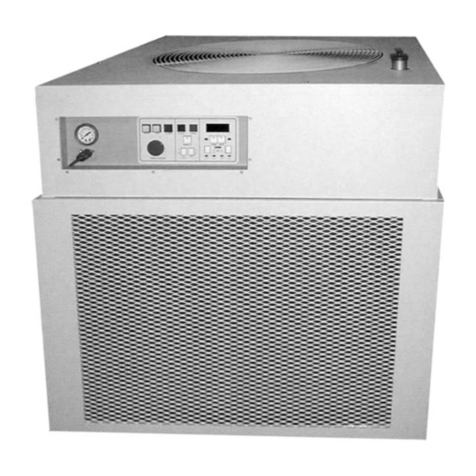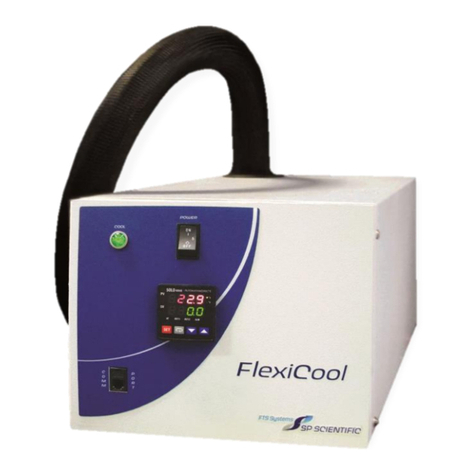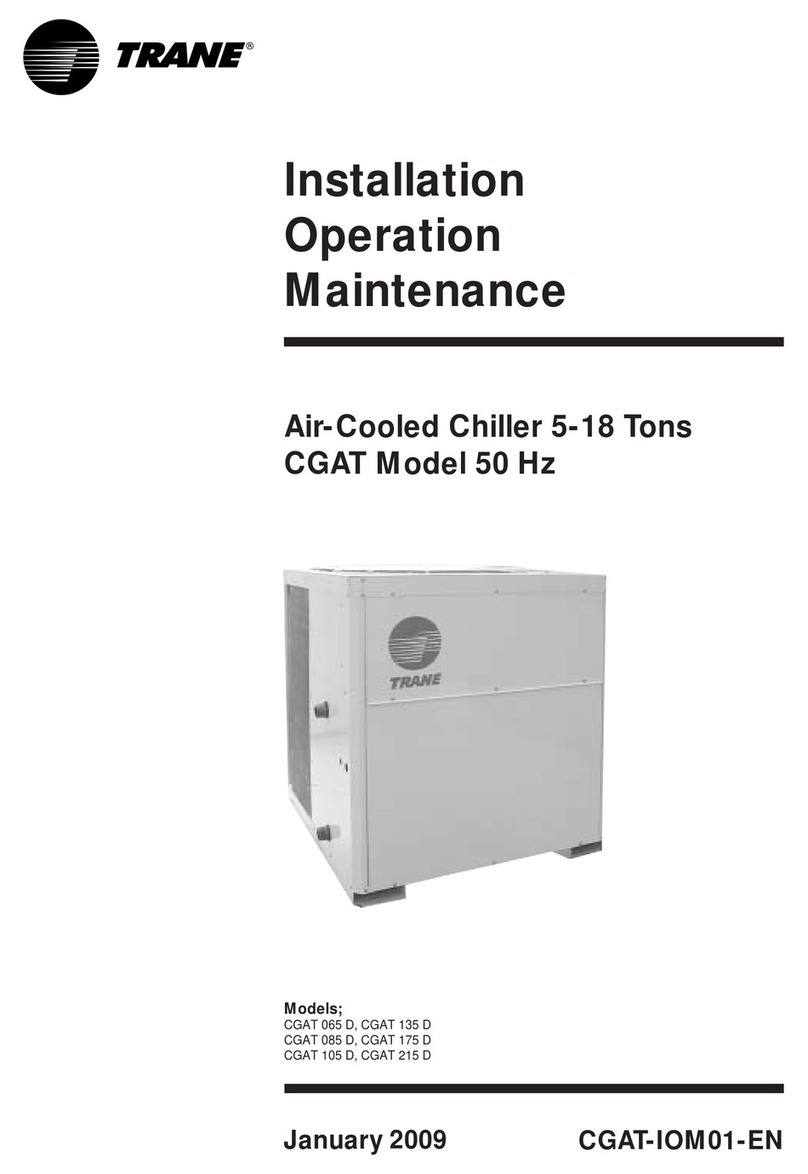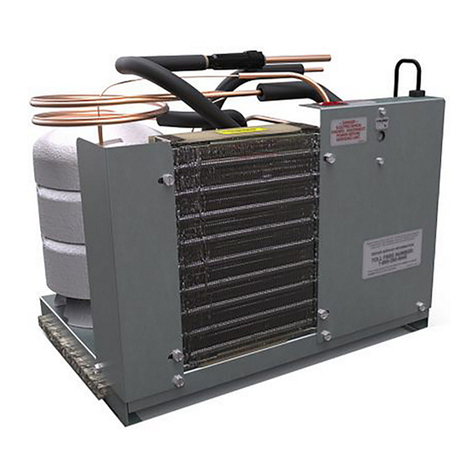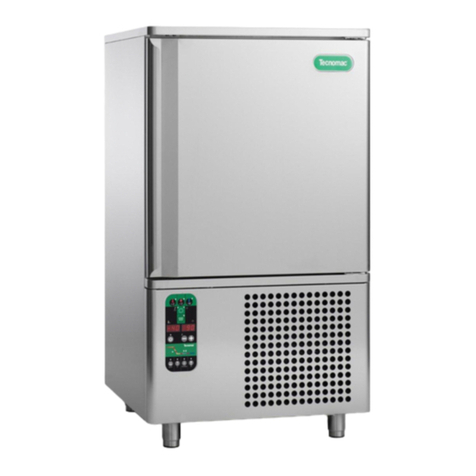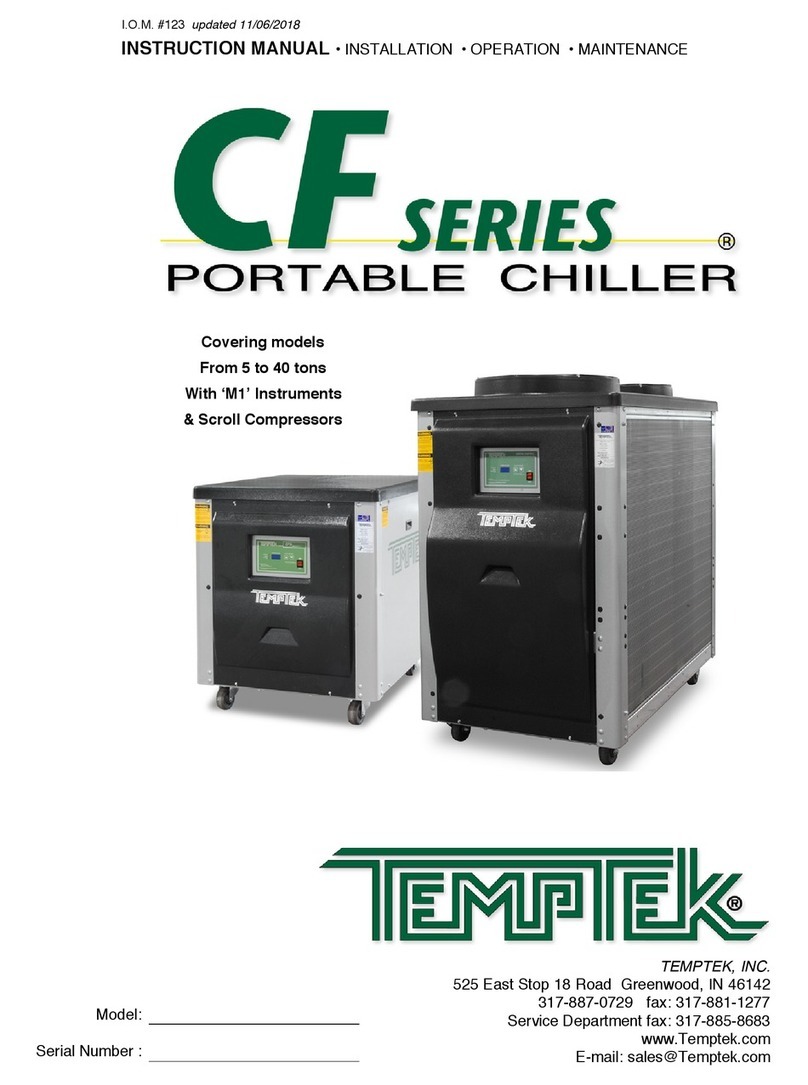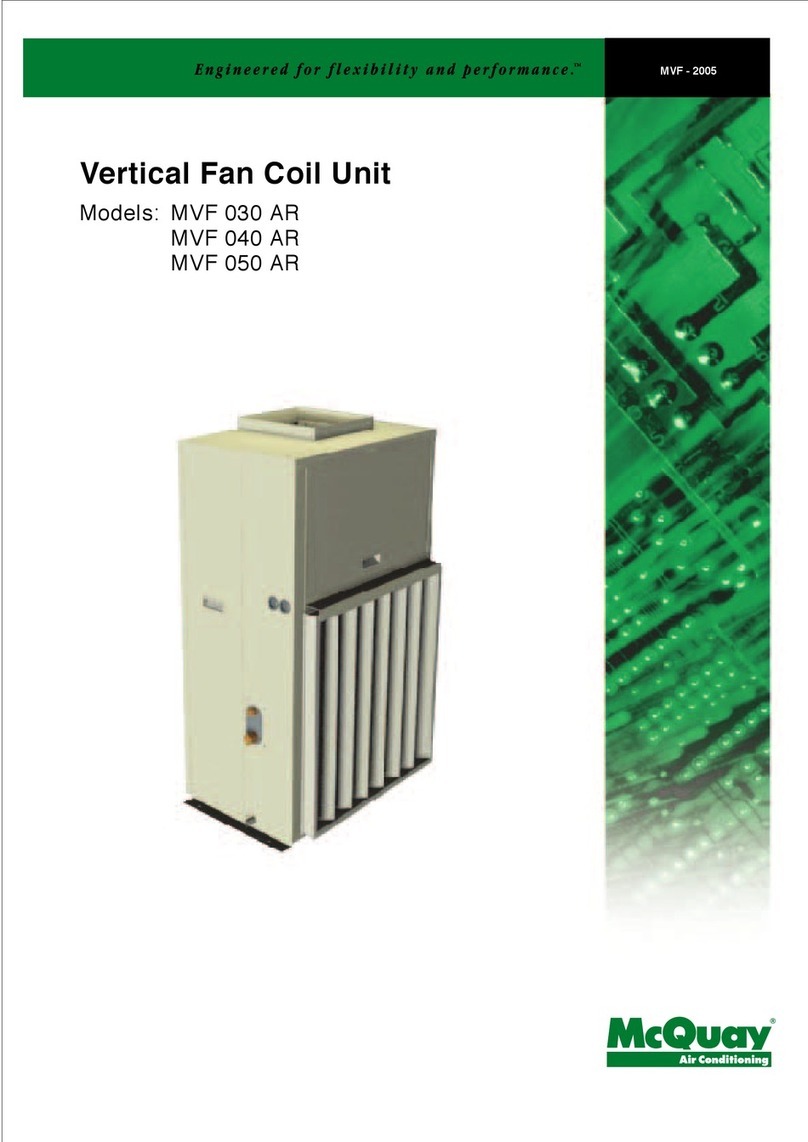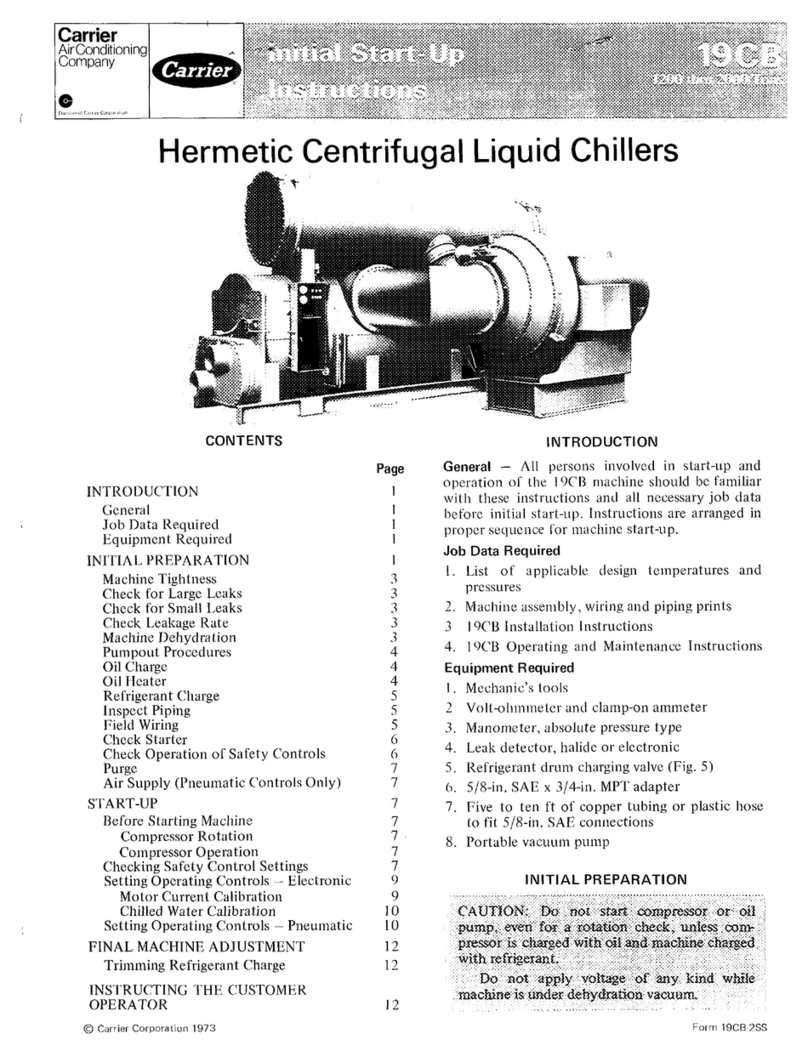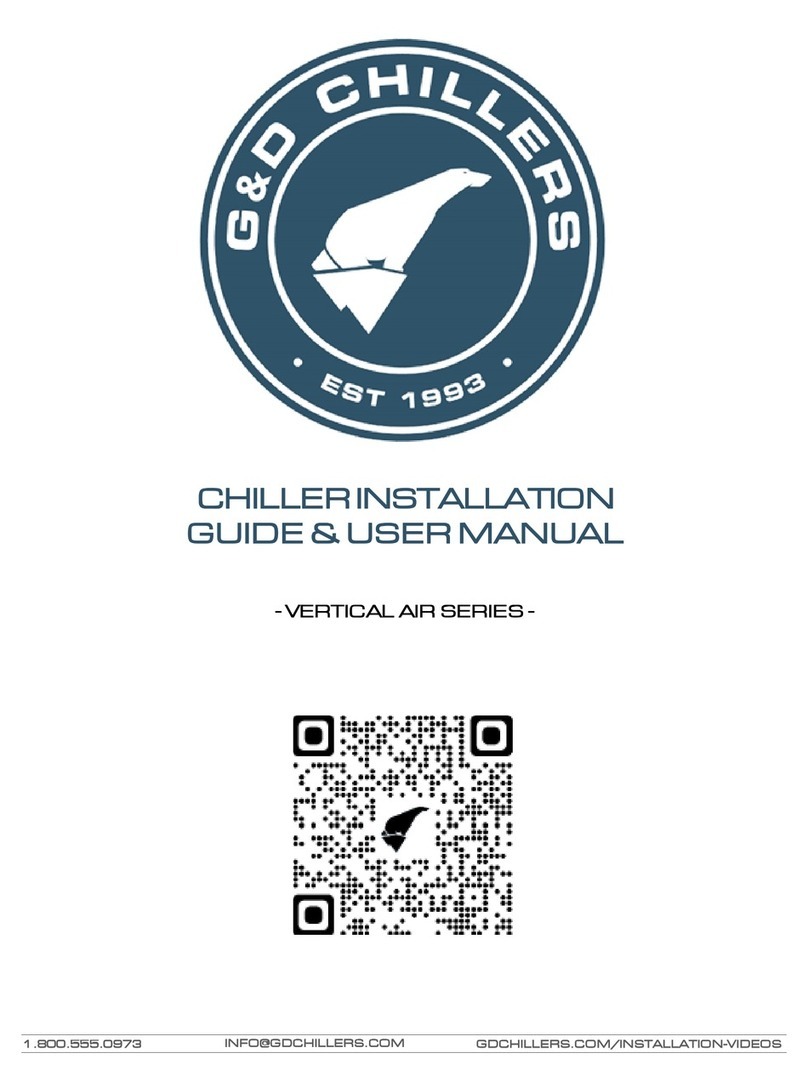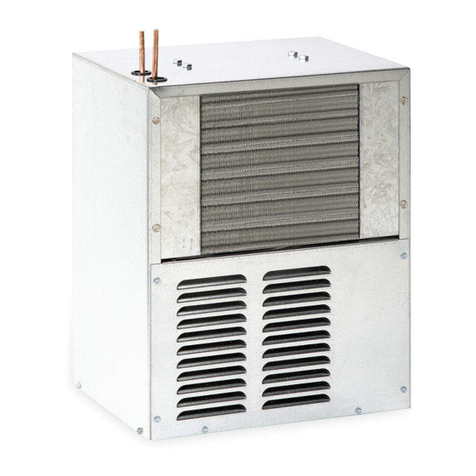SP Scientific RS Series User manual

RECIRCULATING CHILLER OPERATOR’S MANUAL
RS44XX2MCT
C
HILLER
RS SERIES CHILLER


Rev 004, 04/12 i
© SP Scientific 2012
Copyright © 2012 SP Scientific. All marks herein are used under license.
All brand or product names mentioned may be trademarks or registered trademarks of their respective
companies.
Part Number MNL-061-A
Rev 004, 04/12
SP Scientific
815 State Route 208
3538 Main Street
Gardiner, NY 12525 USA
Stone Ridge, NY 12484
USA
(800) 431-8232
(845) 255-5000
SP Scientific Service
(877) 548-4666
SP Scientific Service Fax
(845) 687-0024
Website
http://www.spscientific.com/
This Recirculating Chiller Operator’s Manual contains confidential and proprietary information of SP
Scientific and may be used only by a recipient designated by and for purposes specified by SP Scientific.
Reproduction of, dissemination of, modifications to, or the creation of derivative works from this
Recirculating Chiller Operator’s Manual, by any means and in any form or manner, is expressly
prohibited, except with the prior written permission of SP Scientific. Permitted copies of this document
must retain all proprietary notices contained in the original.
The information in this document is subject to change without prior notice. Always confirm with SP
Scientific that you are using the most current version of this document. SP Scientific is free to modify any
of its products and services, in any manner and at any time, notwithstanding the information contained in
this document.
THE CONTENTS OF THIS DOCUMENT SHALL NOT CONSTITUTE ANY WARRANTY OF ANY KIND,
EITHER EXPRESSED OR IMPLIED, INCLUDING BUT NOT LIMITED TO THE IMPLIED WARRANTIES
OF MERCHANTABILITY AND/OR FITNESS FOR A PARTICULAR PURPOSE OR GIVE RISE TO ANY
LIABILITY OF SP SCIENTIFIC, ITS AFFILIATES OR ITS SUPPLIERS.
The terms and conditions governing the use of this Recirculating Chiller Operator’s Manual shall consist
of those set forth in written agreements with SP Scientific.

ii Rev 004, 04/12
© SP Scientific 2012
Important Symbols
WARNING! INJURY OR EVEN
DEATH MAY RESULT IF A
RECOMMENDATION MARKED
WITH THIS SYMBOL IS NOT
HEEDED.
CRUSH HAZARD. KEEP HANDS
CLEAR WHEN OPERATING DOOR.
ELECTRIC SHOCK DANGER!
USE APPROPRIATE CAUTION
TO AVOID INJURY OR DEATH.
CORROSIVE CHEMICAL. WEAR
SUITABLE GLOVES, SAFETY
GLASSES, AND PROTECTIVE
CLOTHING.
BURN DANGER! POTENTIALLY
HOT SURFACE. USE
APPROPRIATE CAUTION.
PROPERTY CAUTION! TO PREVENT
DAMAGE TO CHAMBER EQUIP-
MENT AND/OR LOAD, ADHERE TO
PROCEDURES MARKED BY THIS
SYMBOL.
DO NOT STORE FLAMMABLE
MATERIALS IN CHAMBER.
PRACTICAL OPERATING TIP.
THESE RECOMMENDATIONS
STREAMLINE UNIT OPERATION
AND PREVENT COMMON
OPERATOR ERRORS.
WEAR SAFETY GLASSES.
EXPLOSIVE MATERIALS HAZARD!
KEEP OBJECTS AWAY FROM HEAT.
Safety Warnings
Always transport the unit with care. Sudden jolts or drops may damage the refrigeration system.
Always observe all warning labels.
Always turn off the unit and disconnect the line cord from the available power source prior to performing anyservice or maintenance procedures.
Always turn off the unit and disconnect the line cord from the available power source prior to moving the unit.
Always empty the reservoir / bath chamber prior to moving the unit.
Never operate equipment with damaged line cords.
Never operate the unit without cooling fluid in the reservoir / bath chamber.
Never remove warning labels.
Never operate damaged or leaking equipment.

Rev 004, 04/12 iii
© SP Scientific 2012
Warranty Information
RS44XX2MCT Chillers are warranted by SP Scientific to be free of defects in material and workmanship when
operated under normal conditions as specified in the instructions provided in this manual. Please take this opportunity
to locate the serial tag on your new RS44XX2MCT Chiller and record the information below for future reference. SP
Scientific also recommends that you complete and return your unit’s warranty registration card.
Model Number
Serial Number
Part Number
Limited Warranty
SP Scientific (the “Company”) shall warrant each of its products against defects in material or workmanship for a period
of 12 months from the date of shipment provided that the product is used in a reasonable manner under appropriate
conditions and consistent with the applicable operating instructions.
The obligation of the Company shall be, at its option, to repair or replace, without charge any parts that prove to be
defective within the warranty period, if the purchaser notifies the Company promptly in writing of such defect. No
product shall be returned to the Company without prior approval of the Company.
This limited warranty shall cover the costs of parts and labor to repair or replace all defective product(s) at the Seller’s
factory. For all products installed by the Company and located within the Company service travel areas, this warranty
shall cover transportation charges to ship the product to and from the Company’s factory and/or the costs of travel,
room and board if the Company’s employees conduct repair at the Buyer’s location. In lieu of repair or replacement at
the Company’s factory, the Company may, in its discretion, authorize a third party to perform the repair or replacement
at the Buyer’s location, and at the Company’s sole expense.
The Company shall not be responsible for labor charges payable with respect to persons other than Company
employees. Replacement or repair of parts pursuant to this warranty shall not in any way extend the original warranty
period. The Company shall not be responsible for any unauthorized repairs, replacements or product modifications, nor
will it be responsible for any product failures resulting from such unauthorized repairs, replacements or product
modifications negligently or otherwise made by persons other than Company employees or authorized representatives
of the Company. The buyer shall assume transportation charges to ship the product to and from the Company’s factory
and the costs of travel, room and board if the Company’s employees conduct repair at the Buyer’s location within the
warranty period if the product was not installed by the Company’s and/or is not located within the Company’s service
travel areas.
THE COMPANY DOES NOT MAKE AND EXPRESSLY DISCLAIMS ANY WARRANTY OF MERCHANTABILITY OR
FITNESS FOR A PARTICULAR PURPOSE OR ANY OTHER WARRANTY, EXPRESSED OR IMPLIED, WITH
RESPECT TO THE SALE, INSTALLATION, DESIGN OR USE OF ITS PRODUCTS. ADDITIONALLY, THE
COMPANY SHALL NOT BE LIABLE FOR ANY CONSEQUENTIAL DAMAGES RESULTING FROM THE USE OF OR
ANY DEFECTS IN ITS PRODUCTS.
The Company’s employees are available to provide general advice to customers concerning the use of the Company’s
products; however, oral representations are not warranties with respect to particular products or their uses and may not
be relied upon if they are inconsistent with the relevant product specifications for the items set forth herein.
Notwithstanding the above, the terms and conditions set forth in the Company’s formal sales contracts shall be
controlling and supersede any inconsistent terms contained herein, and any changes to such contracts must be made
in writing and signed by an authorized executive of the Company.
WARNING! THE DISPOSAL AND/OR EMISSION OF SUBSTANCES USED IN CONNECTION WITH
THIS EQUIPMENT MAY BE GOVERNED BY VARIOUS FEDERAL, STATE OR LOCAL
REGULATIONS. ALL USERS OF THIS EQUIPMENT ARE URGED TO BECOME FAMILIAR WITH
ANY REGULATIONS THAT APPLY IN THE USERS AREA CONCERNING THE DUMPING OF
WASTE MATERIALS IN OR UPON WATER, LAND OR AIR AND TO COMPLY WITH SUCH
REGULATIONS.

iv Rev 004, 04/12
© SP Scientific 2012

Rev 004, 04/12 v
© SP Scientific 2012
Contents
Important Symbols...............................................................................................................................................ii
Safety Warnings................................................................................................................................................... ii
Warranty Information .......................................................................................................................................... iii
Introduction .................................................................................................................1
Overview..............................................................................................................................................................1
Key Features...................................................................................................................................................1
Installation and Startup ...............................................................................................3
Initial Inspection...................................................................................................................................................3
Setup and Installation ..........................................................................................................................................4
Physical Location ............................................................................................................................................4
Ambient Conditions.........................................................................................................................................4
Electrical Requirements...................................................................................................................................5
Selecting a Process Fluid................................................................................................................................6
Properties of a Process Fluid ..........................................................................................................................7
Connect to the Process...................................................................................................................................8
Prime the Fluid Loop.......................................................................................................................................9
Operation..................................................................................................................11
System Preparation ...........................................................................................................................................11
Start Up..............................................................................................................................................................11
Control ...............................................................................................................................................................12
Shut Down .........................................................................................................................................................12
User Menu ................................................................................................................13
Overview............................................................................................................................................................13
Buttons..........................................................................................................................................................13
Operating Mode.................................................................................................................................................14
Proportional Control Menu.................................................................................................................................15
SPAN Menu.......................................................................................................................................................16
Miscellaneous Menu ..........................................................................................................................................17
Communications Menu ......................................................................................................................................18
PID Tuning.........................................................................................................................................................19
It and dt .........................................................................................................................................................20
CCt................................................................................................................................................................20
CPb ...............................................................................................................................................................21

Contents
RS44XX2MCT Chiller
vi Rev 004, 04/12
© SP Scientific 2012
System Alarms...................................................................................................................................................21
Low Fluid Level .............................................................................................................................................21
High Fluid Temperature.................................................................................................................................22
Low Fluid Temperature..................................................................................................................................22
Maintenance .............................................................................................................23
Lockout/Tagout Procedure.................................................................................................................................23
Fuse Replacement.............................................................................................................................................24
Cleaning.............................................................................................................................................................25
Draining Fluid.....................................................................................................................................................26
RS-232 Communications..........................................................................................27
Overview............................................................................................................................................................27
Hardware ...........................................................................................................................................................27
Communications................................................................................................................................................29
Communication Data .........................................................................................................................................29
Data Format.......................................................................................................................................................29
Received Data ...................................................................................................................................................30
Transmitted Data ...............................................................................................................................................32
Transmitted Data Format...................................................................................................................................33
Acknowledge.................................................................................................................................................33
Error ..............................................................................................................................................................33
Value.............................................................................................................................................................33
Terminator.....................................................................................................................................................34
Commands and Codes ......................................................................................................................................34
Command Set ...............................................................................................................................................34
Alarm Codes..................................................................................................................................................41
RS-232 Error Codes......................................................................................................................................42
Sample Program................................................................................................................................................45
Program.........................................................................................................................................................45
Appendix A: Troubleshooting....................................................................................47

Rev 004, 04/12 1
© SP Scientific 2012
Chapter
1
Introduction
Overview RS Series Chillers are portable, caster-mounted systems that provides temperature
controlled fluid over a wide range. All SP Scientific chillers feature innovative design,
high-quality construction, and highly reliable components. This chiller will dependably
serve your cooling needs for years to come.
Key Features
Small Footprint.
Digital / RS-232 Control.
± 0.1C Stability.
Wide Temperature Range.
Mechanical Refrigeration (Air- Cooled).

Introduction
RS44XX2MCT Chiller
2 Rev 004, 04/12
© SP Scientific 2012

Rev 004, 04/12 3
© SP Scientific 2012
Chapter
2
Installation and Startup
Initial Inspection
Your RS44XX2MCT Chiller was carefully packed and thoroughly inspected before
leaving the SP Scientific factory. However, in the unlikely event that shipping damage
has occurred, retain all packing material and contact your freight carrier immediately.
DO NOT ACCEPT DAMAGED SHIPMENTS FROM A CARRIER WITHOUT A SIGNED
NOTIFICATION OF DAMAGES.
Upon receiving your shipment, inspect all contents of your equipment for damage.
Uncrate and/or unwrap the unit. Carefully remove all packing material from the unit
and inspect for visible damage. Check packing material for small accessory items.
Inspect the inside of the unit and related parts for visible damage and leaks. Check for
visible liquid at or near the base of the unit. The bath chamber should be clean and
dry.
If concealed damage or loss is discovered, contact the freight carrier immediately.
1
Keep all contents, packing material and related paperwork intact until a written report
is obtained.
Note: SP Scientific will cooperate in the matter of collecting your claim, but is not responsible
for the collection or free replacement of the material. When possible, replacement parts will be
shipped and invoiced to you, making them a part of your claim.
1
“Concealed damage or loss”refers to damage or loss that does not become apparent until the merchandise has been
unpacked and inspected. Should damage or loss be discovered, you may make a written request for inspection by the carrier's
agent within 15 days of the delivery date. You may then file a claim with the freight carrier or SP Scientific, depending on the
terms of your shipment. If your shipment was “FOB Destination” file your claim with SP Scientific and include the inspection
report and any other supporting documents. If your shipment was “FOB Shipping Point” file your claim with the freight carrier
and include the inspection report and any other supporting documents.

Installation and Startup
RS44XX2MCT Chiller
4 Rev 004, 04/12
© SP Scientific 2012
Setup and Installation
Physical Location
The RS44XX2MCT Chiller is designed for bench-top installation in a laboratory
environment. The area where you place the unit should be smooth, level, and capable
of safely supporting the weight of the machine. Space should be provided so that air
can properly circulate around the unit. If obstacles are blocking the airflow, the
compressor may overheat. This reduces performance, and can lead to early
compressor failure.
The environment should be well ventilated to prevent excessive buildup of heat.
Normal room ventilation is usually adequate.
NEVER PLACE THE UNIT IN AND AREA WHERE EXCESSIVE HEAT, MOISTURE OR
CORROSIVE MATERIALS ARE PRESENT.
Ambient Conditions
This unit is designed for operation in a normal indoor environment. Systems should
not be mounted outside or otherwise exposed to the elements. The environment
should be free from air containing large amounts of moisture, salt or sulfur. If your
system utilizes an air-cooled condenser, the fan in the system draws ambient air
across the condenser (radiator) to cool the refrigerant.
Ambient Air Temperature Requirements
12C to 21C(55F to 69F)
Acceptable
21C to 24C(70F to 75F)
Ideal
24C to 27C(75F to 80F).
Acceptable, but a reduction in the cooling capacity of the unit is to be
expected (about a 1% cooling capacity reduction per degree above
72F).
27C to 29.5C (80F to 85F)
Expect reduced reliability. Warranty may be voided.
Over 29.5C( Over 85F)
Not Acceptable. Warranty will be voided.

RS44XX2MCT Chiller
Installation and Startup
Rev 004, 04/12 5
© SP Scientific 2012
Electrical Requirements
CAUTION! IF YOU ARE UNSURE ABOUT THE AVAILABLE ELECTRICAL VOLTAGE SUPPLY IN
YOUR FACILITY, CONSULT A QUALIFIED ELECTRICIAN.
The voltage and frequency requirements are specified on the serial tag on the rear of
the unit. Standard variances in frequency (±3Hz) and voltage (-5%, +10%) are
allowed.
Verify that the facilities voltage matches the requirement for the machine,which is printed on the serial tag on the rear of the machine.
The electric service wiring must be of a large enough wire gauge that thevoltage is maintained to the receptacle even when a full load is applied to the
receptacle. Additionally, the receptacle voltage should be measured while
that receptacle is under load.
Ensure the proper amperage circuit breaker is installed in the line and locatednear the equipment.
Plug in the line cord. (Avoid the use of long extension cords, these cause asignificant power drop between the wall receptacle and the machine.)
When the unit is plugged in the amber POWER light on the front panel shouldilluminate.
Note: For Lock Out/Tag Out, plug the appropriate device into the line cord.

Installation and Startup
RS44XX2MCT Chiller
6 Rev 004, 04/12
© SP Scientific 2012
Selecting a Process Fluid
Fluid
Temperature
Range(°C)
Flammability
Toxicity
Dielectric
Ethylene Glycol/Water
60/40 Mix
-25/60
Low
Low
Low
Galden™ by Ausimont
HT-30 Silicone Oil
-60 / +100
Low
Very Low
High
HT-70
-85 / +35
None
Very Low
Very High
HT-90
-75 / +65
None
Very Low
Very High
HT-110
-69 / +80
None
Very Low
Very High
HT-135
-59 / +100
None
Very Low
Very High
HT-170
-39 / +135
None
Very Low
Very High
This recirculator is designed for operation with a host of industry standard fluids.
Which fluid you choose will depend partly on what temperature range you require.
Ethylene Glycol and water (60/40 mix) is an inexpensive and readily available fluid for
–25C to +60C. If you require a fluid outside this temperature range, SP Scientific
suggests using HT-30 Silicone Oil for –60C to +100C. If you require a completely
non-flammable fluid SP Scientific suggests Galden™ fluids made by the Ausimont
Company, (800) 323-AUSI. Galden™ fluids are non-flammable, inert, and non-toxic.
There are other fluids available, but to avoid potential application problems and to
speed troubleshooting; it is suggested that one of the fluids mentioned above be used.
DO NOT USE AUTOMOTIVE ANTI-FREEZE (it contains clotting agents). If for some
reason one of the above fluids is not suitable, and you select a different one, be sure
that it has a viscosity of less than 20 centistokes over the full temperature range of the
unit.
Note: All of the above mentioned fluids have viscosity of less than 20 centistokes across their
useable temperature ranges.
Since most systems have capability to achieve temperatures below 0C, water
should not be used as a process fluid, unless you have purchased a deionized
water compatible system (these systems offer a maximum low temperature capacity
of +8°C and a maximum high temperature of +80°C).

RS44XX2MCT Chiller
Installation and Startup
Rev 004, 04/12 7
© SP Scientific 2012
Properties of a Process Fluid
Expansion/Contraction
It is important to note that some fluids expand as much as 14% from 25 °C to 125 °C.
Do not confuse contraction of the fluid for fluid losses. Also, open the red vent screw
on the reservoir lid when changing the setpoint (the temperature at which the unit will
stabilize).
Fluid Creep
Fluids will find any non-sealed connection.
Dissolved Gases
At room temperature, the fluid contains dissolved gas. As the fluid temperature is
increased the amount of dissolved gasses decreases dramatically, causing excess
gas to be released from the fluid. The release of gas should not be mistaken for
boiling of the fluid.
Water Solubility
Process fluids are water-soluble. After long periods of operation at low temperatures,
water from the air will condense on and mix with the fluid. This decreases the
performance of the system. To remove excess water, warm the fluid to room
temperature and pump the fluid through a molecular sieve or desiccant material.
Alternately, simply run the system at room temperatures over 100 °C, this will boil off
any water present in the fluid (only applies to the systems that are capable of
temperatures over 100 °C).
Low Surface Tension and High Vapor Pressure
This means that the fluid evaporates very easily and that any improperly sealed joints
will leak. Close the red vent screw on the reservoir lid to prevent evaporation of the
fluid, but remember to open the vent screw when changing setpoints (the fluid
expands and contracts with temperature changes).

Installation and Startup
RS44XX2MCT Chiller
8 Rev 004, 04/12
© SP Scientific 2012
Connect to the Process
SP Scientific provides input and output connections for the process fluid. To tie these
lines into your process, you will require:
1/4” Fittings for 1/4” male pipe thread on the fluid I/O ports.
Pipe Insulation. Closed cell pipe insulation will work for most applications,which can be purchased from any local refrigeration or plumbing supply
house.
Glue seams of pipe insulation.
Polytetrafluoroethylene (PTFE) tape pipe sealant to seal all fittings.

RS44XX2MCT Chiller
Installation and Startup
Rev 004, 04/12 9
© SP Scientific 2012
Prime the Fluid Loop
At this point your unit should be hooked up to the proper electrical service and all
plumbing necessary for operation should be in place and sealed. Fluid can be added
to the reservoir, and the system can then be primed.
Remove the reservoir lid on the top of the unit.1.
CORROSIVE CHEMICAL!. WEAR SUITABLE GLOVES, SAFETY GLASSES, AND PROTECTIVE
CLOTHING.
WEAR SAFETY GLASSES.
Add process fluid to reservoir until it is 1" (2.5cm) from the top and replace the2. lid.
Press the I/O button.3.
When the reservoir drops to 1/3 full, press the I/O button to stop the pump.4.
Remove the reservoir lid.5.
Add fluid to reservoir until it is again 1" (2.5cm) from the top and replace the6. lid.
Restart the pump by pressing the I/O button again.7.
Continue this process until the entire fluid loop is primed and the reservoir8. level remains 1" (2.5cm) from the top.
Your unit is now fully installed and ready to operate.

Installation and Startup
RS44XX2MCT Chiller
10 Rev 004, 04/12
© SP Scientific 2012

Rev 004, 04/12 11
© SP Scientific 2012
Chapter
3
Operation
System Preparation
Plug the unit in if it is not already been done.1.
System is now in Idle.2.
Display will be blank and the amber Power light will be illuminated.3.
Start Up Press the I/O button.1.
Display flashes SP (setpoint) then the current setpoint temperature (the2. setpoint is the fluid temperature that the unit will maintain).
Adjust the Setpoint using the ▲▼ keys.3.
The value for setpoint will be accepted after 4 seconds of inactivity.4.

Operation
RS44XX2MCT Chiller
12 Rev 004, 04/12
© SP Scientific 2012
Control When the system is running touch the ▲ button to bring up the setpoint.1.
Adjust the setpoint using the ▲▼ keys.2.
Note: When changing setpoint, loosen the red vent screw on the reservoir lid to
accommodate for the expansion/contraction of the process fluid. Once the chiller
stabilizes at a setpoint, tighten the red vent screw. This will help prevent excess
evaporation of the fluid, as well as preventing atmospheric moisture from condensing
on the fluid.
The setpoint is automatically accepted after 4 seconds.3.
Shut Down Press the I/O button to put the unit back in Idle.1.
The refrigeration will shut down and the display will blank.2.
The amber Power light will remain lit.3.
Vent Screw
This manual suits for next models
1
Table of contents
Other SP Scientific Chiller manuals
